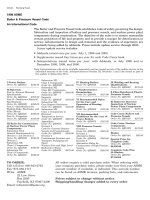Process Engineering Equipment Handbook Episode 2 Part 10 ppsx
Bạn đang xem bản rút gọn của tài liệu. Xem và tải ngay bản đầy đủ của tài liệu tại đây (1.28 MB, 50 trang )
Pollutants, Chemical; Pollutants, (from) Chemical Processes; Pollutant Indicators; Pollutants, Toxic; Pollutants, Toxic Chemicals P-67
FIG. P-8 Illegal chemical dumping. (Source: Environment Canada.)
FIG. P-9 Monitoring water quality is a year-round job. (Source: Environment Canada.)
recognized by all. Canada has been in close consultation with the United States on
such matters as the cleanup of the Niagara River. Both the federal and Ontario
governments have developed or announced plans for the control and management
of toxic chemicals. Inventories of toxic substances, crisis planning, cradle-to-grave
tracking of toxics, and extensive investigative programs are a few of the measures
being taken or advocated. Canada and Ontario together spend nearly $10 million
per year monitoring and diagnosing the condition of the Great Lakes, with special
attention paid to toxics. Great pains are taken to ensure that the United States has
access to extensive Canadian environmental data, and the two nations cooperate
through the Great Lakes International Surveillance Plan. Although drinking water
supplies meet present guidelines, these guidelines cover only a small percentage of
the many chemicals that occur in the Great Lakes. Clearly, the toxics situation
cannot be allowed to deteriorate further.
The toxics issue must be solved in two basic ways. First, as much as possible of
the hazardous wastes that already exist must be destroyed or recycled, and when
necessary, safe methods must be used to store wastes that cannot be destroyed.
Second, industrial wastes must be eliminated or reduced, at their source, to the
fullest extent possible. Plants must be designed to produce no waste, or as little as
possible; greater efficiency means less waste. This is the long-term answer to the
problem—human ingenuity. Such things as closed-loop systems and waste exchange
(whereby the wastes of one process become the raw materials of another) can
minimize or eliminate entirely the need for the disposal of toxic wastes. Systems
like this already exist, and they are economically feasible.
P-68 Pollutants, Chemical; Pollutants, (from) Chemical Processes; Pollutant Indicators; Pollutants, Toxic; Pollutants, Toxic Chemicals
FIG. P-10 Monitoring water quality is a year-round job. (Source: Environment Canada.)
Society already has the technology necessary to reduce and eliminate toxics
entering the Great Lakes. Whether we use it is a matter of will. If we want
the benefits that chemicals can give us, then we must act responsibly in their use
and disposal. If we don’t clean up our act, we’ll poison ourselves. It’s as simple as
that.
Demographic predictions. The present population in the Great Lakes basin is
around 37 million; this is expected to double in the next 40 years. Sixty percent of
Ontario’s population now lives in the six major urban centers of Toronto, Hamilton,
Ottawa, Kitchener-Waterloo, London, and Windsor, all within the Great Lakes
watershed. It is forecast that by 2020 this will rise to 80 percent.
By the year 2020, the United States will require in the Great Lakes basin:
For power generation, 15 times more land than at present.
For power generation, 13 times more cooling water.
Eight times more industrial water.
Five times more irrigation water.
Twice as much sewage capacity.
Twice the present amount of land devoted to urban use.
Wastewater flows
Case study: British Columbia townships. Sewage treatment plants (STPs), which are
operated by the Greater Vancouver Sewerage and Drainage District, discharge
enough wastewater each year to fill B.C. Place Stadium 160 times. Flows have
increased by 60 percent since 1976 for the Annacis plant and are expected to double
by 2036. Flows from the Iona plant, which are now discharged to a deep sea outfall
in Georgia Strait, are expected to remain at their current level, while steady growth
is expected for the Lulu Island plant. Primary sewage treatment removes
suspended particles from the waste stream and the remaining waste water is
chlorinated in the summer months. STPs also produce sludges that can be
contaminated with heavy metals.
Between Kanaka Greek and Hope, six municipal STPs discharge approximately
35,000 m
3
/day of secondary-treated* effluent. Steady growth is expected for these
areas. Throughout the Lower Fraser River Basin there are approximately 20 small
private STPs treating effluent from schools, marinas, trailer parks, or other
developments. Almost one-half the 1360 m
3
/day of effluent discharges from these
sources are to ground disposal systems. (See Figs. P-11 and P-12.)
Effluents from the Annacis and Lulu Island STPs frequently contain higher levels
of contaminants than permitted by the provincial government. For the Annacis
plant permit, noncompliance is most apparent for Biochemical Oxygen Demand
(BOD),
†
toxicity, oil and grease, and dissolved oxygen. For example, in 1985 toxicity
levels were exceeded 50 percent of the time for Annacis and 66.7 percent of the time
for Lulu Island STPs. The toxic compounds identified in municipal STP effluent
include un-ionized ammonia, cyanide, sulfides, chlorine, chloramines, phenols,
anionic surfactants, heavy metals, and organic compounds. Table P-5 provides a
Pollutants, Chemical; Pollutants, (from) Chemical Processes; Pollutant Indicators; Pollutants, Toxic; Pollutants, Toxic Chemicals P-69
* After primary treatment, secondary treatment involves using either anaerobic bacteria (which do not
use oxygen) or aerobic bacteria (which use oxygen) to treat the sewage.
†
BOD—the oxygen required for the biochemical breakdown of organic material and the oxidation of
inorganic materials such as sulfides and iron.
P-70 Pollutants, Chemical; Pollutants, (from) Chemical Processes; Pollutant Indicators; Pollutants, Toxic; Pollutants, Toxic Chemicals
FIG. P-11 Summary of wastewater flows to the Fraser River estuary and Boundary Bay, 1987.
(Source: Environment Canada.)
FIG. P-12 Distribution of discharges in the Lower Fraser River Basin authorized by B.C. Ministry
of Environment Permits in 1987. (Source: Environment Canada.)
Pollutants, Chemical; Pollutants, (from) Chemical Processes; Pollutant Indicators; Pollutants, Toxic; Pollutants, Toxic Chemicals P-71
summary of annual contaminant loadings and characteristics for the Annacis, Lulu,
and Iona STPs.
Due to tidal conditions in the Fraser River, this effluent can pool and spread
across the river within two hours at slack tide, exposing millions of juvenile salmon
and eulachon larvae during downstream migrations. During low river flows, the
effluent from Annacis STP, for example, can reside in the river for up to 1.7 days.
Major concerns exist regarding the lethal and sublethal effects of the toxicity of the
effluent on both anadromous and nonanadromous fish in terms of bioaccumulation,
stress, disease, reproduction, feeding behavior, etc. Despite these concerns there are
no techniques currently in place to link these effects to overall impacts on fish
populations.
Industrial effluent. Authorized discharges from chemical, concrete, food, forest,
gravel washing, metal fabricating and finishing, port industries, and other
industrial sectors in the Lower Fraser River Basin total almost 300,000 m
3
/day, 90
TABLE
P-5 Sewage Treatment Plant Contaminant
Loadings, 1985
Parameter (kg/day) Iona Annacis Lulu
Discharge (m
3
/day) 466,789 291,791 41,230
Oxygen demand 37,810 45,519 5,731
Suspended solids 26,607 20,717 2,639
Kjeldahl nitrogen 7,469 7,587 1,237
Ammonia 4,108 4,669 817
Fluoride 75 44 5.8
MBAS* 420 554 87
Sulfate 12,137 7,878 1,484
Calcium carbonate 33,609 30,930 4,535
pH 3,361 2,013 284
Phosphorus (diss) 840 905 136
Phosphorus (total) 1,354 1,314 219
Oil and grease 7,469 8,462 1,278
Phenol 14 15 1.6
Boron (diss) 75 85 13
Aluminum (diss) bdl bdl 33
Aluminum (total) ai 233 115
Cadmium (total) ai ai 0.07
Chromium (total) bdl bdl 6.2
Copper (diss) 19 15 2.1
Copper (total) 47 41 6.6
Iron (diss) 135 236 41
Iron (total) 415 525 111
Lead (diss) ai 3.8 0.7
Lead (total) 20 12 2.4
Manganese (diss) 23 20 2.5
Manganese (total) 28 29 3.7
Nickel (diss) bdl ai 4.9
Nickel (total) bdl ai 6.2
Zinc (diss) 37 29 6.2
Zinc (total) 56 50 14
NOTES:
Derived by multiplying finite effluent concentrations by the STP average
reported flows for 1987.
ai: average indeterminate
bdl: below detection level
*MBAS: methylene blue active substances; ingredient in detergents and
foaming agents.
SOURCE
: Environment Canada.
P-72 Portland Cement
percent of which occur in the estuary. This is a drop from discharges of 351,571
m
3
/day in 1973 probably due to industrial hookups to Annacis Island STP in 1975.
Of 116 authorized waste management permits, 11 contribute about 80 percent of
total industrial effluent flows.
Pollutant loadings include oil, grease, solids, metals, and organics. Total loadings
are difficult to determine as permit requirements may not include all parameters,
reporting periods and sampling methodology vary between permits, a few permit
holders are in noncompliance situations, and unauthorized discharges may be
occurring. Analysis of data for the 63 industrial permit holders on the Fraser River
below Kanaka Creek show reported loadings of 4739 kg/day of BOD, 7226 kg/day
of solids, 342 kg/day of oil and grease, and 5780 kg/day of nutrients. High priority
industrial dischargers have been identified based on their flows and contaminant
loadings.
Reference and Additional Reading
1. Soares, C. M., Environmental Technology and Economics: Sustainable Development in Industry,
Butterworth-Heinemann, 1999.
Portland Cement (see Cement)
Power Production; Power Production In-House; IPP; SPP
The acronym IPP generally refers to firms that existed for the sole purpose of
investing in and building power plants and selling the power to a national governing
body or other large customers. IPP ranks are swelling to include “small” power
producers, whose production of power is secondary to their main purpose.
Small producers include large industrial entities, such as refineries and
manufacturing plants, that buy their own power production machinery (sometimes
to avoid expensive brownouts or outages) and make their own power. In most
countries they can sell their excess power back to the national grid. The limits of
this sale are generally set by the size of the distribution lines available. This small
power producer generally gets less of a tariff for its power than it pays for national
grid-supplied power. As such power producers increase, they lessen demand growth
and therefore the required size of new, large power plants.
National power authorities traditionally move with a sluggishness that struggles
to keep up with increasing power demand and changes in environmental legislation.
However, the nature of the contemporary power business forces certain other
optimization measures as the following paragraph indicates.
A power station in Dagenham, England, with both Alberta (Canada) power and
English partners for owners, is an IPP. In anticipation of CO
2
(carbon dioxide)
emissions legislation, the firm ordered a high-precision condition-monitoring system
for its power-generation turbines. Their logic: the system would optimize fuel
consumption and cut down on CO
2
emissions. Current technology made the cost of
the system initially ordered unnecessarily high; nonetheless, the trend is clear.
Note also that, generally, IPPs have to have the mental flexibility to see the return
on investment of such a system. The potential effect on the national power to IPP
power production ratio in the future is evident. If national power producers do not
react swiftly to changing environmental pressures, their profitability margins could
decrease to the point where IPPs can further encroach on their territory.
One lesson learned from the severe ice storms suffered by Canada and the United
States early in 1998 is that smaller IPP installations might prove less of an “Achilles
heel” (weak link) to overall power demand than a few large national power plants.
Sagging national nuclear industries in Canada, the United States, and Japan are
testament to overly optimistic life prognoses of nuclear fission reactors. They have
been, and will continue to be, decommissioned. This can result in several smaller
IPPs taking up the slack.
If the process plant does not want to “go it alone” to be an IPP, other willing
partners may be available. IPP ranks are further being swelled by IPP joint-venture
companies that can have one of the turbine manufacturers, such as Alstom
[formerly ABB (Asea Brown Boveri)] or Siemens, as a major or controlling-interest
partner. Interesting variations on a theme can be arranged contractually with
original equipment manufacturers (OEMs). Alstom had a turnkey arrangement on
the Kuala Langat, Malaysia, plant with the Genting Corporation, Malaysia, and
the Lumut, Malaysia, plant with Segari Ventures, Malaysia. The pulp mill next to
the Kuala Langat plant exchanges steam with its power-generation neighbor.
Transmission and distribution systems in the vicinity also provide scope for
minimizing hardware.
IPP Trends Globally
IPP conglomerates that include an OEM or large contractor, such as Enron, will
continue to increase. Partners for many of these ventures include major oil and
process firms. The advantage gained by joining forces with an OEM can include
bargaining the terms of comprehensive maintenance contracts. If they team up with
a major contractor, they may thus have negotiated a plant expansion for optimized
dollars per unit of capacity. Alstom, for instance, is starting to increase its
ownership of power facilities, even partially owned state or municipality ones, in
the United States, such as the massive Midland plant. Alstom’s participation in
long-term comprehensive maintenance contracts in power projects, such as Deeside
in the United Kingdom, serve to illustrate how entwined OEMs now are with the
IPP sector. Quite apart from the return-on-investment figures that a “plain”
investor might consider, the profit margin on spare parts and the markup on
maintenance or construction services further add to the attraction of IPP projects
for OEMs and contractors.
Deregulation of the power industry, increasing environmental legislation, and the
increased difficulty of maintaining profit margins serve to accelerate the gradual
turnover of national power authorities’ territory to IPPs. The nuclear industries in
Canada, the United States, and Japan are likely to provide further illustration of
this fact in the near future.
More and more, “IPP” can mean “small IPP.” As tax incentives for internal power
production rise, some countries that were formerly opposed to SPPs are now lifting
their objection. Singapore is one such example. The corresponding number of firms
who then qualify to invest as IPPs increases correspondingly.
Oil and gas companies increasingly make their own power. They then become
their own best customer. This trend is further stepped up as technology makes
viable fuel selections of many of the “unwanted” by-products these facilities
produce. The resultant economic benefits of producing their own power escalate
further over time. An excellent example of this is seen under Stepper Motor Valves
(a subsection of Control Systems) with the example of the PCS plant in Singapore.
Power Transmission
Power transmission is the act of taking power from a driving piece of equipment
(such as a gas turbine, steam turbine, or motor) and transmitting it to a driven
piece of equipment (such as a compressor or a pump). Power-transmission
Power Transmission P-73
equipment then includes gears and gearboxes, couplings, and other systems that
transmit power from the “driver” to the “driven.”
In this section, model numbers used by the information source companies will
appear, as in other sections in this book. Care was taken to get source information
from suppliers with the widest product ranges currently available, so the reader
can then use this information as a basis for comparison with other OEMs being
considered.
Gears*
Helical gears
Gears are associated with nearly every human activity in the modern world. They
come in all sizes, shapes, and materials. They go by such names as spur, helical,
bevel, hypoid, worm, skew, internal, external, epicyclic, and so on.
The following material is presented to assist an engineer who is not a gear
specialist in determining the basic size and requirements of a gearset for one
specific type of gearing: high-speed, high-power parallel-axis gears. The industry
definition of high speed is 3600 rpm and/or 5000 ft/min pitch-line velocity. In this
instance, high power means from 1000 to 2000 hp at the low end and upward of
50,000 hp at the high end. The kinds of applications that generally require high-
speed gearing are those involving steam and gas turbines, centrifugal pumps and
compressors, and marine propulsion equipment.
High-speed gears. Gears for high-speed service are usually of the helical type. They
can be either single- or double-helical and can be used in either single or double
stages of increase or reduction, depending on the required ratio. The ratio of a single
stage is usually limited to about 8 to 1. There is a very small difference in frictional
loss at the teeth, depending on whether the pinion or the gear is driven, but for all
practical purposes no distinction need be made between speed increasers and speed
reducers.
Most high-speed gearing operates at pitch-line velocities of 25,000 ft/min or less.
At higher speeds, up to about 33,000 ft/min, special consideration must be given to
many aspects of the gearset and housing. Speeds of over 33,000 ft/min should be
considered developmental.
As gears go faster, the need for gear accuracy becomes greater. The following can
be used for guidelines for high-speed gearing. Tooth-spacing errors should not
exceed about 0.00015 in; tooth-profile errors, about 0.0003 in; and helix or lead
error, as reflected by tooth contact over the entire face, about 0.0005 in. The usual
range of helix angles on single-helical gears is between 12 and 18°. For double-
helical gears, the helix is generally between 30 and 40°. Pressure angles are usually
found between 20 and 25° (in the plane of rotation).
In addition to the requirement for extreme accuracy, a characteristic of high-speed
helical gears that sets them apart from other helicals is the design objective of
infinite life, which in turn results in fairly conservative stress levels.
Overload and distress. If a gearset is overloaded from transmitting more than the
design power, or by being undersized, or as a result of misalignment, the teeth are
likely to experience distress. The three most probable forms of distress are pitting,
tooth breakage, and scoring.
P-74 Power Transmission
* Source: Demag Delaval, USA.
Pitting is a surface-fatigue phenomenon. It occurs when the hertzian, or surface,
compressive stresses exceed the surface-endurance strength.
Tooth breakage is exactly what the name implies: sections of gear teeth literally
break out. It occurs when the bending stresses on the flank or in the root of the
teeth exceed the bending-fatigue strength of the material.
Scoring, sometimes called scuffing, is actually instantaneous welding of particles
of the pinion and gear teeth to each other. It occurs when the oil film separating
the teeth becomes so hot that it flashes or so thin that it ruptures, thereby
permitting metal-to-metal sliding contact. The heat generated as the pinion and
gear teeth slide on each other is sufficient to cause localized welding. These tiny
welds are immediately torn loose and proceed to scratch the mating surfaces—hence
the name scoring.
Neither pitting nor scoring causes immediate shutdown. If allowed to progress,
however, they can produce a deterioration of the involute profiles in addition to
producing stress risers. If permitted to continue too long, pitting or scoring can lead
to tooth breakage.
Basic sizing. The basic sizing of a gearset, or what can be called the preliminary
design, is based on resistance to pitting. Since the surface endurance strength is a
function of the material hardness, preliminary sizing of a gearset is relatively
simple. It should be understood, however, that the final design requires the efforts
of a competent gear engineer to investigate and attend to such matters as:
1. The selection of materials and processing
2. The determination of the number of teeth on the pinion and gear, which is a
function of the pitch, which in turn determines the tooth bending strength
3. An investigation of the scoring resistance of the gearset, which is a function of
the gear-tooth geometry, the surface finish of the teeth, and the properties of the
lubricant
4. Rotor proportions and bearing design, with particular interest in related
vibration characteristics
5. Gear-case features, including such things as running clearances, proper
drainage, venting, mounting, doweling, and, in particular, maintenance of
internal alignment
6. The many system considerations such as lateral and torsional vibration, external
alignment with associated forces and moments on shaft ends, torque pulsations,
etc.
The American Gear Manufacturers Association’s (AGMA) fundamental equation
for surface durability (pitting resistance) of helical gear teeth is
(P-1)
where s
c
= contact-strength number
C
L
= life factor
C
H
= hardness-ratio factor
C
T
= temperature factor
C
R
= factor of safety
˙
1 p
1-m
p
2
E
p
+
1-m
G
2
E
G
È
Î
Í
Í
Í
Í
˘
˚
˙
˙
˙
˙
12
¥
Î
<
=
s
c
C
L
C
H
C
T
C
R
È
Î
Í
˘
˚
W
t
C
o
C
v
C
s
dF
C
m
C
f
I
È
Í
˘
˚
˙
12
Power Transmission P-75
m
p
, m
G
= Poisson ratio for pinion and gear
E
p
, E
G
= modulus of elasticity for pinion and gear
W
t
= transmitted tangential load at pitch diameter
C
o
= overload factor
C
v
= dynamic factor
C
s
= size factor
d = pinion pitch diameter
F = face width
C
m
= load-distribution factor
C
f
= surface-condition factor
I = geometry factor
Substituting appropriate values for high-speed gears and rearranging Eq. (P-1)
results in
(P-2)
where K is an index of hertzian stress. It is defined mathematically as:
(P-3)
where R = ratio (D/d)
D = gear pitch diameter
W
t
= tangential tooth load
and
hp = transmitted, or design, horsepower
N
p
= pinion, rpm
The term C
o
, the overload factor, is accounted for by application service factors (SF),
shown in Table P-6.
The term C
m
, the load-distribution factor, accounts for maldistribution of load
across the face width of the gearset due to lateral bending and torsional twisting
of the pinion, thermal distortion of the pinion and/or the gear, and centrifugal
deflection of the gear. If the length-diameter ratio (L/d) of the pinion is kept within
reasonable limits, usually less than 2.2 for double-helical and 1.5 for single-helical
gears, and proper attention is paid to cooling and gear-band deflection, the
magnitude of the C
m
factor will probably lie between 1.2 and 1.4. If the higher value
is used in the interest of conservatism, Eq. (P-2) can be further simplified to
(P-4)
By using Eqs. (P-3) and (P-4) and Tables P-6 and P-7, the basic size of a high-speed
gearset can be determined in several minutes on a hand calculator.
Table P-7 gives values of s
c
for commonly used gear materials. The rating of a
gearset should be based on the softer of the two members, which is normally the
gear. The Brinell hardness of the pinion in through-hardened gearsets is usually
about 1.2 times that of the gear.
Arrangements. Figures P-13 and P-14 show sections through a typical industrial
high-speed-gear unit. See Table P-6.
K
s
c
£
-
¥
()
¥
-
10 1 11
4
2
.
SF
=
¥
¥
126 000,hp
Nd
p
K
W
Fd
R
R
t
=¥
+ 1
Ks
CC
c
om
=
<
¥
[]
¥
-
10
156
4
2
.
P-76 Power Transmission
Power Transmission P-77
Figures P-15 and P-16 show sections through a typical turbine-driven marine
propulsion reduction gear. It will be noted that the high-speed pinions each mesh
with two first-reduction gears, thereby splitting the power from each turbine. These
twin-power-path gears, or so-called locked-train gears, are popular in the
horsepower range of 30,000 shp and up.
Figures P-17 and P-18 show sections through a typical diesel-driven marine
propulsion reduction gear. In this arrangement, each pinion is fitted with a
pneumatically operated clutch that permits either engine to be operated singly or
one engine ahead and one astern for fast maneuvering.
TABLE P-6 Service-Factor Values
Service Factor
Prime Mover
Internal-Combustion
Application Motor Turbine Engine (Multicylinder)
Blowers
Centrifugal 1.4 1.6 1.7
Lobe 1.7 1.7 2.0
Compressors
Centrifugal: process gas except air conditioning 1.3 1.5 1.6
Centrifugal: air-conditioning service 1.2 1.4 1.5
Centrifugal: air or pipeline service 1.4 1.6 1.7
Rotary: axial flow—all types 1.4 1.6 1.7
Rotary: liquid piston (Nash) 1.7 1.7 2.0
Rotary: lobe-radial flow 1.7 1.7 2.0
Reciprocating: three or more cylinders 1.7 1.7 2.0
Reciprocating: two cylinders 2.0 2.0 2.3
Dynamometer: test stand 1.1 1.1 1.3
Fans
Centrifugal 1.4 1.6 1.7
Forced-draft 1.4 1.6 1.7
Induced-draft 1.7 2.0 2.2
Industrial and mine (large with frequent-start cycles) 1.7 2.0 2.2
Generators and exciters
Base-load or continuous 1.1 1.1 1.3
Peak-duty cycle 1.3 1.3 1.7
Pumps
Centrifugal (all service except as listed below) 1.3 1.5 1.7
Centrifugal: boiler feed 1.7 2.0 . . .
Centrifugal: descaling (with surge tank) 2.0 2.0 . . .
Centrifugal: hot oil 1.5 1.7 . . .
Centrifugal: pipeline 1.5 1.7 2.0
Centrifugal: waterworks 1.5 1.7 2.0
Dredge 2.0 2.4 2.5
Rotary: axial flow—all types 1.5 1.5 1.8
Rotary: gear 1.5 1.5 1.8
Rotary: liquid piston 1.7 1.7 2.0
Rotary: lobe 1.7 1.7 2.0
Rotary: sliding vane 1.5 1.5 1.8
Reciprocating: three cylinders or more 1.7 1.7 2.0
Reciprocating: two cylinders 2.0 2.0 2.3
Marine service
Ship’s service turbine-generator sets . . . 1.1 . . .
Turbine propulsion . . . 1.25 . . .
Diesel propulsion . . . . . . 1.35
P-78 Power Transmission
TABLE
P-7 s
c
Values
Gear Hardness s
c
Through-hardened 229BHN 112,000
248BHN 117,500
302BHN 135,000
340BHN 152,000
Nitrided 55R
c
207,000
58R
c
218,700
60R
c
226,800
63R
c
239,400
Case-carburized 55 R
c
230,000
58R
c
243,000
60R
c
252,000
63R
c
266,000
NOTE: BHN = Brinell hardness number; R
c
= Rockwell number.
FIG. P-13 Plan cross section, typical industrial gear. (Source: Demag Delaval.)
Power Transmission P-79
FIG. P-14 End cross section, typical industrial gear. (Source: Demag Delaval.)
FIG. P-15 Plan cross section, typical locked-train reduction gear. (Source: Demag Delaval.)
P-80 Power Transmission
FIG.
P-16 End cross section, typical locked-train reduction gear. (Source: Demag Delaval.)
FIG. P-17 Plan cross section, typical diesel propulsion reduction gear. (Source: Demag Delaval.)
Power Transmission P-81
Horsepower losses. Prediction of gear-unit losses is an inexact science at best. The
total power loss of a gear unit is made up of (1) the frictional loss in the oil film
separating the teeth as they slide over one another, (2) bearing losses, and (3)
windage and pumping losses.
Empirical equations have been developed for most types of gears to calculate
these losses. Often rule-of-thumb estimates are as good as the calculations. Tooth-
mesh losses usually amount to between 0.5 and 1 percent of the transmitted horse-
power at each mesh. Bearing losses may vary a bit more, depending primarily on
the bearing type, operating clearance, and sliding velocity. They usually fall into a
range of 0.75 to 1.5 percent of transmitted power.
Windage losses depend primarily on the clearance between rotating parts and the
housing, the smoothness of the surfaces, and the peripheral velocities.
Pumping loss, the displacement of the air-oil mixture from the tooth space as
engagement takes place, is influenced by tooth size, helix angle, rotative speed, and
location of the oil sprays. Losses of this type are the biggest variable and can fall
anywhere from 0.5 to about 2 percent of transmitted power.
The most important consideration is that a realistic view be taken of gear losses
when selecting a pump, cooler, and filters for the lubrication system. These should
be large enough to do the job.
Lubrication. The oils normally used in high-speed-gear applications are rust- and
oxidation-inhibited turbine oils in the viscosity range of 150 to 300 SSU at 100°F.
As a general rule, the higher the pitch-line speed of the gear, the lower the viscosity
oil required. In marine units, in which the propeller shaft turns at a relatively low
speed, pitch-line speeds are frequently found below 5000 ft/min. In these cases, it
is generally desirable to use a more viscous oil. The viscosity of the oils frequently
found in turbine-driven propulsion plants is in the range of 400 to 700 SSU at 100°F.
In diesel propulsion gearing, in which the engine and the gear are on separate
systems, the viscosity of the gear oil is frequently in the range of 600 to 1500 SSU
at 100°F.
FIG.
P-18 End cross section, typical diesel propulsion reduction gear. (Source: Demag Delaval.)
Regardless of the application, the scoring or scuffing resistance of the gear teeth
should be investigated. In many cases, it will be desirable to use an oil with
appropriate extreme-pressure additives that greatly increase the antiweld or
antiscoring characteristics of the lubricant.
Installation and maintenance. If a gear unit is correctly sized, properly installed, and
properly maintained, it can be expected to last indefinitely. Proper installation
includes (1) proper initial alignment, both internal and external, and (2) a rigid
foundation that will not settle, crack, or elastically or thermally deform under
operating conditions in amounts greater than the gear-alignment tolerance.
For those interested in additional information on systems considerations
(overloads, system vibration, alignment, foundations, piping, and lubrication),
AGMA Information Sheet 427.01, Systems Considerations for Critical Service Gear
Drives, is recommended.
Proper maintenance consists primarily of providing a continuous supply of the
correct lubricant at the right temperature, pressure, and condition. Obviously,
alignment and balance must be maintained. Vibration monitoring is a good
preventive-maintenance tool. Figure P-19 can be used as a guide for acceptable
lateral-vibration limits. Additional information regarding vibration instruments,
interpretation, tests, etc., may be found in AGMA Standard 426.01, Specification
for Measurement of Lateral Vibration on High Speed Gear Units.
Worm gears
The use of high-speed drivers for efficient operation makes speed reduction
necessary for many applications.
Worm-gear reducers are very compact, requiring less space than belts, chains, or
trains of open gearing. The right-angle drive often permits compact placement of
the driving and driven machines. Since three or more teeth are always in contact,
P-82 Power Transmission
FIG.
P-19 Acceptable vibration levels. (Source: Demag Delaval.)
Power Transmission P-83
there is an even flow of torque, which reduces vibration, prolongs the life of the
driven machinery, and provides quiet power transmission. There are few moving
parts (hence few bearings), and these are enclosed in a dustproof housing that
contributes to long life and avoids danger of injury to workers.
Worm gearing consists of an element known as the worm, which is threaded like
a screw, mating with a gear whose axis is at a 90° angle to that of the worm. The
gear is throated and partially envelops the worm. The worm may have one or more
independent threads, or “starts.”
The ratio of speeds is determined by dividing the number of teeth in the gear by
the number of threads in the worm. Since a single-threaded worm acts like a gear
with one tooth and a double-threaded worm as a gear with two teeth, very large
ratios can be designed into one set of gearing. Ratios between 3 to 1 and 100 to 1
are common for power transmission purposes, and even higher ratios are employed
for index devices.
Mechanical elements. Dimensions of the worm and worm gear are defined as follows
(see Fig. P-20):
Outer diameter of worm is the diameter of a cylinder touching the tops of the
threads.
Pitch diameter of worm is the diameter of a circle that is tangent to the pitch
circle of the mating gear in its midplane.
Outer diameter of gear is the diameter over the tips of the teeth at their highest
points.
Throat diameter of gear is the diameter over the tips of the teeth at the middle
plane that is perpendicular to the axis of the gear shaft and passes through the
axis of the worm.
FIG. P-20 Worm gear terminology. (Source: Demag Delaval.)
Pitch diameter of gear is the diameter of the pitch circle at the midplane of the
gear that would roll upon the pitch line of the worm if the latter were used as a
rack.
Circular pitch is the distance from a point on one gear tooth to the same point of
the succeeding tooth measured circumferentially on the midplane pitch circle. It is
equal to the axial pitch of the worm, that is, the distance from any point on a thread
of the worm to the corresponding point on the next thread, measured parallel to
the axis.
Lead of worm is the distance parallel to the axis of the worm from a point on a
given thread to the corresponding point on the same thread after it has made one
turn around the worm. If the worm has only one thread, this distance is equal to
the circular pitch, but if the worm has multiple threads, it is equal to the circular
pitch multiplied by the number of threads. It is the distance that a point on the
pitch circle of the gear is advanced by one revolution of the worm.
One revolution of the worm advances the gear by as many teeth as there are
threads on the worm. Therefore, the ratio of transmission is equal to the number
of teeth on the gear, divided by the number of threads on the worm, without regard
to the pitch.
Lead angle of the worm threads is the angle between a line tangent to the thread
helix at the pitch line and a plane perpendicular to the axis of the worm. The pitch
lines of the worm threads lie on the surface of a cylinder concentric with the worm
and of the pitch diameter. If this cylinder is thought of as unrolled or developed on
a plane, the pitch line of the thread will appear as the hypotenuse of a right-angled
triangle, the base of which will be the circumference of the pitch circle of the worm
and the altitude of which will be the lead of the worm. In Fig. P-21 the lead angle
is g, and the tangent of this angle is equal to the lead L divided by p times the pitch-
line diameter D
w
of the worm, tan g=L/pD
w
.
Pressure angle is defined as the angle between a line tangent to the tooth surface
at the pitch line and a radial line to that point.
Classification. A large number of arrangements are available, permitting flexibility
in application to a wide variety of driven machinery. Some of the typical
arrangements manufactured are shown in Figs. P-22 to P-28.
Motorized units may be furnished for:
Horizontal-shaft units
Single worm reduction
Helical worm reduction
Double worm reduction
Vertical-output-shaft units
Single worm reduction
Helical worm reduction
Double worm reduction
P-84 Power Transmission
FIG. P-21 Lead angle. (Source: Demag Delaval.)
Power Transmission P-85
Shaft-mount units
Single worm reduction
Helical worm reduction
Double worm reduction
Special reducers. Special reducers in various combinations are also available.
An example is presented in Fig. P-29, which shows a large vertical-output-shaft
unit with a single worm reduction having 38-in gear centers, which is used in
pulverized-coal service.
Efficiency of worm gearset. To determine the approximate efficiency of a worm
gearset in which the worm threads are of hardened and ground steel and the gear
FIG. P-22 Single worm reduction. (Source: Demag Delaval.)
FIG.
P-23 Helical worm reduction. (Source: Demag Delaval.)
FIG. P-24 Double worm reduction. (Source: Demag Delaval.)
teeth of nickel bronze or phosphor bronze, lubricated with a steam-cylinder oil, Figs.
P-30 and P-31 may be used. To use the coefficient-of-friction curve, calculate the
rubbing speed of the worm from the following formula:
Rubbing speed, ft min
pitch diameter of worm 0.262 rpm
cos lead angle
=
¥¥
P-86 Power Transmission
FIG. P-25 Vertical single worm reduction. (Source: Demag Delaval.)
FIG. P-26 Vertical double worm reduction. (Source: Demag Delaval.)
FIG. P-27 Double-worm-reduction shaft-mount unit. (Source: Demag Delaval.)
Power Transmission P-87
(See Fig. P-21 for a definition of lead angle.) With this rubbing speed noted at the
bottom of the diagram, read vertically upward until you intersect the coefficient-of-
friction curve. Read the value of the coefficient of friction from the left-hand side of
the diagram.
When the worm is the driver, enter the efficiency diagram with the lead angle of
the worm at the bottom of the diagram. Read upward to the intersection of the
curve with the correct coefficient of friction. The efficiency of the gearset may be
read from the right-hand side of the diagram or the efficiency loss on the left-hand
side of the diagram.
FIG. P-28 Motorized worm reduction. (Source: Demag Delaval.)
FIG. P-29 Large vertical-shaft single worm reduction. (Source: Demag Delaval.)
FIG. P-30 Coefficient-of-friction curve. (Source: Demag Delaval.)
When the gear is the driver, enter the efficiency diagram with the lead angle of
the worm at the top of the diagram, reading down to the curve with the correct
coefficient of friction. Find the efficiency as before.
These efficiencies, while approximate, are very close to the operating efficiency
of the gearset alone. When the gearset is enclosed in a housing with bearings, seals,
and oil reservoir, some allowance must be made for bearing loss, seal drag on the
shaft, and churning of oil.
Self-locking gearset. A self-locking gearset is one that cannot be started in motion
by applying power at the gear. Theoretically, this can be obtained when the lead
angle of the worm is less than the friction angle. For normal static conditions the
friction angle would be approximately 8°30¢, and therefore it might be deduced that
gearsets having a worm lead angle less than this value would be self-locking.
However, it is impossible to determine the point of positive self-locking for several
reasons. The value of the static coefficient of friction varies considerably because of
the effect of a number of variables. Furthermore, if a source of vibration is located
near a self-locked gearset, a very slight motion might occur at the gear contact.
Since the coefficient of friction decreases rapidly with an increase in rubbing
velocity from the static condition, the friction angle may become smaller than the
lead angle. Once this occurs, motion will continue and the gearing will accelerate
under the action of the power applied to the gear.
Figure P-32 indicates the rapid increase in efficiency with increase in rubbing
speed from the static condition for both the worm driving and the gear driving. For
this particular example at a rubbing velocity of 500 ft/min, there are only a few
points of efficiency difference between the two curves.
The best way to obtain locking is to use a brake, released electrically when
the motor is started. With worm gears of high ratios, the braking effect need be
only a fraction of full-load motor torque. A solenoid brake is usually best suited for
this operation since the braking effect may be adjusted by weights that can
be proportioned to stop the load gradually and avoid damage. Dashpots can be
employed to ensure gradual setting of the brake.
Tooth form. The tooth form used by this information source is the involute helicoid.
Figures P-33 and P-34 show the straight generating line tangent to the base circle
and the convex axial section of thread.
P-88 Power Transmission
FIG. P-31 Efficiency diagram for worm gearing. (Source: Demag Delaval.)
Power Transmission P-89
Worm-gear performance is judged in terms of load capacity, smooth, silent
running, and high efficiency. The attainment of these goals requires accurate
methods of producing and inspecting the worm and gear.
Since the involute helicoid worm is based on generation of a straight line tangent
to the base circle, the accuracy of this line is very simple to check (Fig. P-35). This
thread form lends itself to accurate manufacture, inspection, and interchangeability,
as all worms can be checked to calculated measurable dimensions.
FIG. P-32 Comparison of efficiencies at tooth contact (ratio 50 on 20-in-center distance). (Source:
Demag Delaval.)
FIG.
P-33 Generation of tooth form. (Source: Demag Delaval.)
FIG. P-34 Convex axial section of thread. (Source: Demag Delaval.)
All wheels are checked with a master worm to ensure interchangeability and
correctness of form (Fig. P-36).
Tooth contact. The involute helicoid thread form is a calculated form, and the
theoretical contact is maintained more accurately and is more easily determined
than that of any other worm thread, particularly a concave thread flank.
Figure P-37 shows theoretical “lines” of contact that exist between two worm
threads and two gear teeth at a given angular position of the worm. As the worm
rotates in the direction shown, these contact lines move progressively across the
flanks of the worm and gear teeth and are inclined at an angle to the direction of
sliding. This inclined effect is known to give a highly efficient form of surface
lubrication and a low coefficient of friction as compared with a gear form in which
the lines of contact are in the approximate direction of sliding. The contacting
surfaces are always freshly lubricated and are not subject to the undesirable effects
of double contact.
P-90 Power Transmission
FIG. P-35 Inspection of tooth form. (Source: Demag Delaval.)
FIG. P-36 Checking with master worm. (Source: Demag Delaval.)









